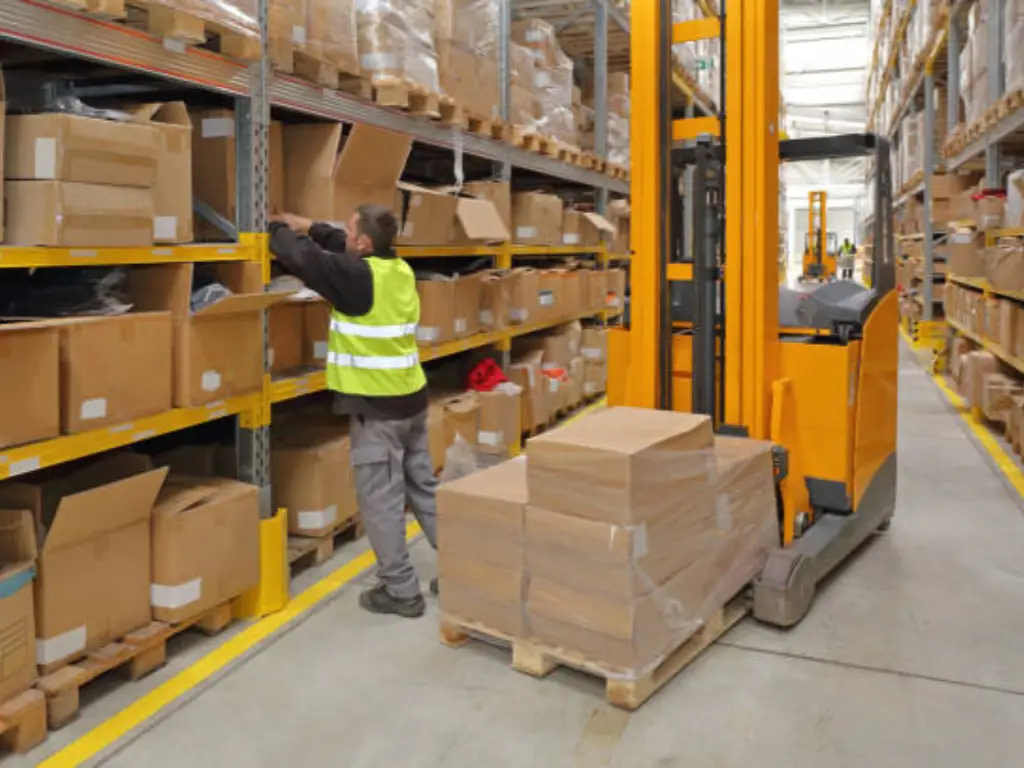Introduction
Customer satisfaction in the new eCommerce is no longer limited to the product, but to the whole process of order fulfilment that delivers the product to the door of the buyer. Each of these steps, including inventory control and delivery on time, determines the customer experience, brand loyalty, and eventually the bottom line of the company. An efficient fulfillment process also helps businesses to enjoy quicker shipping, reduced operational expenses, and satisfied customers. Nevertheless, the best products may result in frustrated customers, postponed deliveries, and ruined reputations when it is not managed well.
This guide discusses the methods of enhancing each stage of your order fulfillment process, the best practices that have been proven, and how a business can streamline its supply chain to achieve long-term success in a competitive eCommerce world today.
Understanding the Order Fulfillment Process

The backbone of any eCommerce company is the order fulfillment process. It is the overall procedure of managing the customer orders, including the procedure of receiving the inventory and the ultimate delivery time. The flow of work is smooth, which guarantees the accuracy of orders, reduces the cost of labor, and improves the efficiency of operations.
The general fulfillment process entails the following fundamental stages:
Of course. Here is the information presented in an English table.
Key Stages of the Order Fulfillment Process :
| Phase | Key Activities |
| Receiving Inventory | Inspecting incoming goods, verifying quantities, and updating inventory counts in your inventory management system. |
| Storage & Warehouse Management | Organizing products for easy access, optimizing storage space, and monitoring inventory levels. |
| Order Processing | Confirming the customer’s order, printing shipping labels, and preparing items for order picking. |
| Picking & Packing | Selecting items efficiently using batch picking or zone picking methods, then packaging them securely. |
| Shipping & Delivery | Choosing optimal shipping methods to balance cost and delivery speed. |
| Returns & Exchanges | Managing reverse logistics and providing strong customer support to protect your reputation. |
Every step has a direct impact on the expectations of customers, and even minor inefficiencies can be multiplied by the increase in the orders volumes.
Why Improving the Fulfillment Process Matters
Poor order fulfillment process may silently cripple any business of eCommerce. It decelerates the business growth, raises the cost of operation, and diminishes customer confidence. Buyers lose trust in a short time when the orders they place are delivered late, incomplete, or with the wrong products, and they rarely come back. Studies always indicate that one of the leading causes of low customer satisfaction and negative reviews is delivery delays and order errors.
In addition to customer perception, inefficient workflow has a direct financial effect. Lack of organization in inventory management, inefficient warehouse management, and lack of consistency in communication translate to increased labor expenses, increased shipping expenses, and storage space wastage. The more the order volumes, the more the errors multiply and this impacts the whole supply chain and the general performance of the business.
Enhancing the fulfillment process does not only involve faster delivery, it involves developing a dependable system that helps in maintaining operational effectiveness, profitability and customer loyalty.
Common Challenges in Order Fulfillment
Even mature brands have problems with inefficiency in fulfillment. The following are some of the typical pain points:
- Incorrect inventory quantities because of manual tracking or disintegrated inventory management software.
- Fragmented systems led to delays in order processing.
- Ineffective warehouse operations layout that causes unwarranted movement and human error.
- Low quality control, which leads to spoilt or wrong deliveries.
- Increasing shipping expenses and labor expenses consuming profit margins.
- Inability to see through sales channels, which causes confusion in order management.
- Inability to use data analytics to predict and optimize.
We have witnessed numerous stores lose their competitiveness due to sluggish delivery and lack of proper supply chain management.
The positive side: all these problems can be resolved through organized procedures and proper technology.
Step-by-Step Guide: How to Improve the Order Fulfillment Process
Step 1: Map and Audit Your Current Workflow

Start with a record of the whole process-order confirmation till shipping labels generation and final delivery time. Measure the accuracy of your current orders, average fulfillment costs, and time per phase using data analytics. This baseline assists in determining the inefficiencies and establishing measurable improvement objectives.
Step 2: Strengthen Inventory Management
Invest in a contemporary inventory management system that updates the stock levels in real time.
By combining inventory management software with your sales channels and order management system, you will reduce overselling, maintain healthy inventory levels, and have the right product at the right time.
Being a dropshipping agent, we tend to offer clients unified dashboards to monitor inventory levels, source of products, and order status at the same time- removing guesswork.
Step 3: Optimize Warehouse Operations
Good order fulfillment depends on efficient warehouse management.
Redesign your distribution center to reduce the amount of walking and adopt digital warehouse management systems that assist in barcode scanning, automated picking paths, and easy access to fast moving products.
Picking methods such as batch picking and zone picking have the potential to enhance picking productivity and minimise human error.
An example of our fulfillment center employs these techniques to process high volumes of orders on behalf of international customers, and thus deliver them on time even during the high sales periods.
Step 4: Automate Order Management
One of the best methods of streamlining operations is automation.
A combined order management system coordinates the sales channels, takes customer orders, prints shipping labels and automatically updates tracking numbers.
You save a lot of labor and enhance the accuracy of orders when automation is used to replace manual data entry.
Step 5: Implement Strong Quality Control
Strong quality management reduces returns and maintains high customer satisfaction.
Conduct inspections prior to the products leaving the fulfillment center to check the packaging, labeling and the state of the products.
With quality control and open order management, you will save your reputation and keep the level of customer service consistent.
Step 6: Choose Reliable Fulfillment Partners
Collaboration with an experienced dropshipping agent or fulfillment center will provide you with access to optimized supply chain infrastructure.
An example is our clients who depend on us to source products, inspect, warehouse and fulfill orders.
Through centralization of these activities, they save on fulfillment costs and have a higher speed of delivery through various sales channels.
Step 7: Use Data for Continuous Improvement
Track performance indicators on a regular basis-order accuracy, delivery time, inventory turnover and customer satisfaction.
Identify trends and bottlenecks using data analytics.
Ongoing optimization ensures that your fulfillment strategy is in line with business expansion and customer changing expectations.
Ready to simplify your fulfillment process?
SpeedBee is a company that focuses on fast and reliable dropshipping fulfillment that bridges the gap between your store and customers worldwide. Our team will make sure that each order is processed correctly and delivered in time, starting with product sourcing and inventory control, through quality control, and shipping. Real-time tracking and single dashboard will ensure that you are in control of your supply chain.
Go to visit speedbeedropship.com to find out how we can simplify your business and help it grow.
Advanced Strategies for Efficient Order Fulfillment
Once the basics are optimized, advanced strategies can take your fulfillment operations to the next level.
Adopt a Lean Fulfillment Strategy: Get rid of unnecessary workflow to increase efficiency. A lean strategy is aimed at waste reduction, minimization of storage space usage, and enhancing the speed of delivery.
Implement Predictive Inventory Management: Proactively use demand forecasting tools to predict the volumes of orders and adjust the inventory levels. This will guarantee that you do not overstock or over-invest in storage or raise fulfillment expenses.
Diversify Fulfillment Centers: Open several distribution centers in strategic locations to reduce delivery time and reduce the cost of shipping. In the case of our international clients we usually handle both domestic and international fulfillment and this enables them to get to their customers at a quicker rate and yet still offer the same level of customer service.
Integrate Supply Chain Management: Unifying supply chain management, warehouse management, and order management within one platform increases visibility and control. When data flows seamlessly, it’s easier to make real-time decisions and sustain business performance.
Key KPIs to Measure Fulfillment Performance
To know whether your improvements are working, track these key performance indicators:
| KPI | Definition / Measurement Focus |
| Order Accuracy Rate | Percentage of correctly shipped orders compared with total orders processed. |
| Average Fulfillment Time | Amount of time from order confirmation to customer delivery, indicating overall efficiency. |
| Inventory Turnover Ratio | How often your inventory levels are sold and replenished within a specific period. |
| Cost per Order | Combines labor costs, shipping costs, and fulfillment costs to show the total expense of processing each order. |
| Customer Satisfaction (CSAT) | Measures how well your customer’s order met expectations, often gathered through post-delivery surveys. |
| Return Rate | Identifies issues in packaging, product quality, or shipping methods by tracking the percentage of returned orders. |
Monitoring these indicators using data analytics and dashboards will guarantee the constant improvement and a healthier bottom line.
The Role of Technology in Modern Fulfillment
Technology drives modern fulfillment operations.
| Tool / System | Purpose and Key Benefits |
| Warehouse Management Systems (WMS) | Optimize warehouse operations, improve storage systems, and manage stock levels efficiently. |
| Order Management Systems (OMS) | Automate order processing, manage sales channels, and ensure smooth communication between suppliers, agents, and couriers. |
| Inventory Management Software | Maintain accurate inventory counts, analyze sales trends, and prevent stockouts. |
| Barcode Scanning & Automation Tools | Reduce human error, boost order accuracy, and shorten order processing time. |
| Data Analytics Platforms | Visualize performance data, optimize fulfillment strategy, and predict future order volumes. |
These systems are well integrated into our network. Clients are able to log in, track order fulfillment and follow through all shipments between the supplier and the customer, all on a single dashboard. This openness creates trust and makes supply chain management easier.
Case Study: Transforming Fulfillment for a Global Dropshipping Brand
A UK retailer with a conventional fulfillment center had a problem of long delivery and inaccurate orders.
Following the collaboration with our team, they centralized inventory control, automated order processing, and introduced a new warehouse management system that was to be used in order to grow fast.
Within three months:
- Delivery speed improved by 45%.
- Order accuracy rose from 94% to 99.6%.
- The average fulfillment costs were reduced by 28%.
- There was an increase in customer satisfaction scores in all the sales channels.
The case shows that data-driven fulfillment operations and high-quality control have a direct impact on business success.
FAQs: Order Fulfillment and Customer Experience
Q1: What is the difference between fulfillment and shipping?
Fulfillment encompasses the complete process, inventory management and order picking, packaging and final delivery time. Shipping is only one of the links to that chain.
Q2: What can small businesses do to enhance fulfillment without making huge investments?
Begin with simple inventory control, organized storage facilities and transparent order control procedures. Then automate and scale slowly.
Q3: What is the role of a dropshipping agent in order fulfillment?
A professional dropshipping fulfillment company deals with sourcing, inspection, packaging, and warehouse services.
This saves on fulfillment costs, enhances accuracy of orders and offers quicker delivery speed.
Q4: Which KPIs are the most significant?
Concentrate on order accuracy, delivery time and customer satisfaction- they have direct impact on your bottom line and business performance.
Conclusion
Enhancing your order fulfillment is not a project; it is a continuous commitment to improvement.
Any adjustments to inventory management, warehouse management, or order management will reinforce your fulfillment strategy and help you provide improved customer service.
With the combination of technology, process discipline, and the assistance of an experienced dropshipping agent, you will be able to realize really efficient order fulfillment.
The outcome is increased customer satisfaction, faster delivery times, reduced fulfillment costs, and long-term business growth.
We assist global eCommerce brands to simplify their supply chain, manage their warehouse, and succeed in business with smarter logistics at our fulfillment center.
When you are willing to make operations lean, improve customer experience, and grow with confidence, then we should discuss how our fulfillment system can support your next phase of growth.



